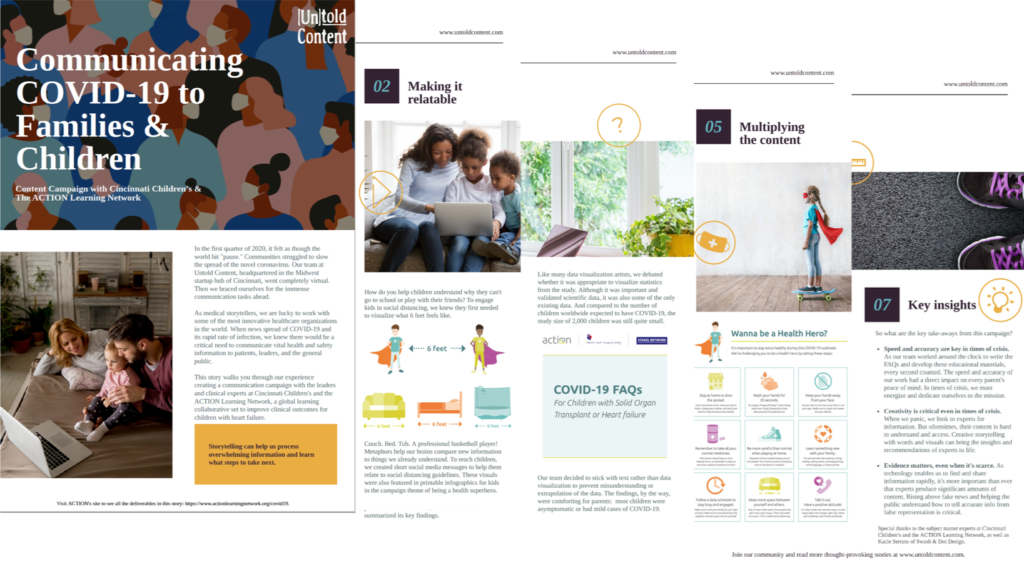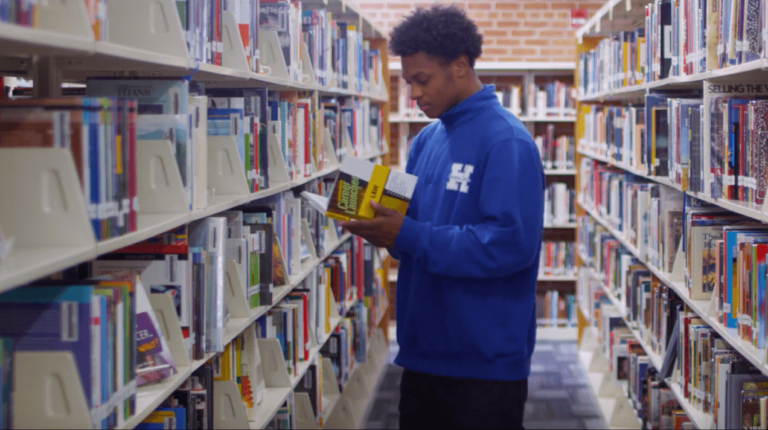Case Story:
COVID19 Content Campaign Inspires Health Heroes During the Pandemic
Challenge
When news spread of COVID-19 and its rapid rate of infection, there was a critical need to communicate vital health and safety information to the public, healthcare leaders, patients and their families.
Solution
Our content creators created a communication campaign in collaboration with medical experts around the globe to help communities understand COVID-19.
Results
A line chart visual of “flattening the curve” swept the nation. Graphics on “How to be a Health Hero” got picked up by CNN. Most importantly, vital health information was shared.
Case Study: COVID-19 Content for Cincinnati Children's Hospital and ACTION Learning Network
As soon as news of the pandemic began, Cincinnati Children’s Hospital and ACTION received a wave of questions from concerned parents. ACTION, the largest nationwide effort to improve outcomes for pediatric heart failure and VAD patients, specifically needed to communicate vital health and safety information to parents of children with solid organ transplants or heart failure.
One of the most urgent needs, therefore, was an accurate, timely, evidence-based FAQ document. ACTION partnered with the Starzl Network for Excellence in Pediatric Transplantation and the Pediatric Heart Transplant Society to collaboratively answer parents’ questions.
Our medical writers then gathered the three organizations’ responses into an FAQ and edited for a consistent voice and style. Most importantly, we added to the research they cited and carefully summarized the clinical outcomes to date. When the first study on pediatric cases of COVID-19 was published in March 2020, the Untold team summarized its key findings. Based on CDC guidelines for effective patient education materials, our team “chunked” the most important information into clear, kid-friendly graphics. Additionally, we shared smaller chunks of content on social media over a two-week period.
All in all, these FAQ, infographics, and social media posts allowed us to share critical health and safety information to help communities understand COVID-19.
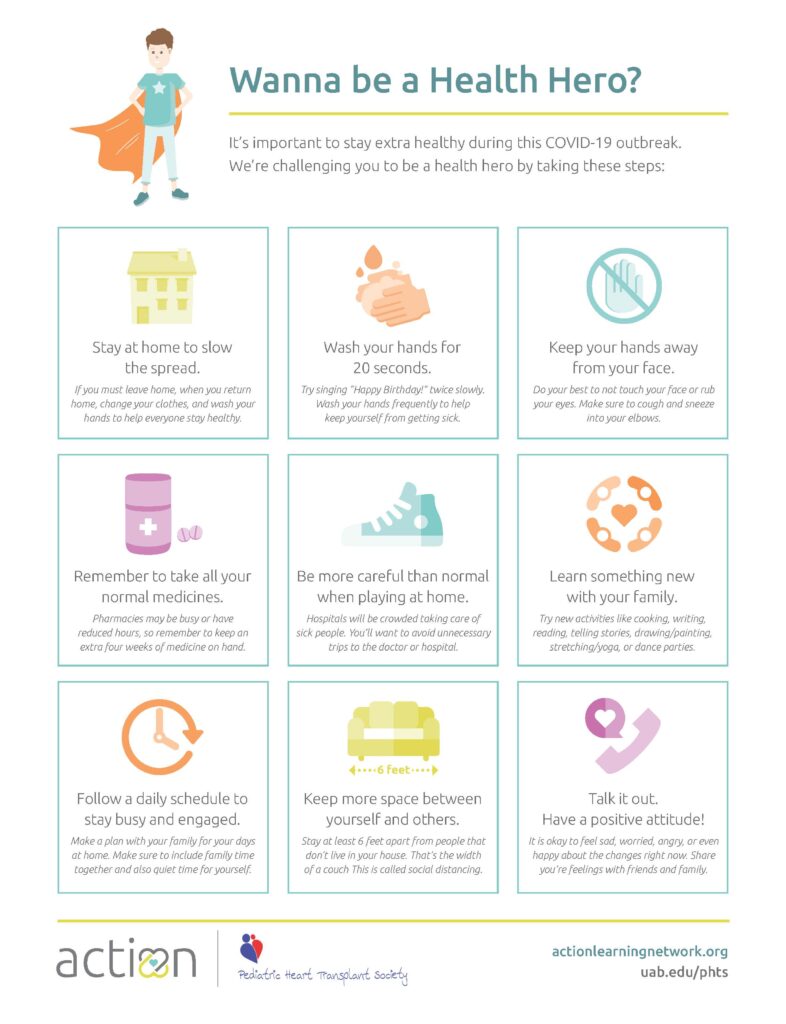
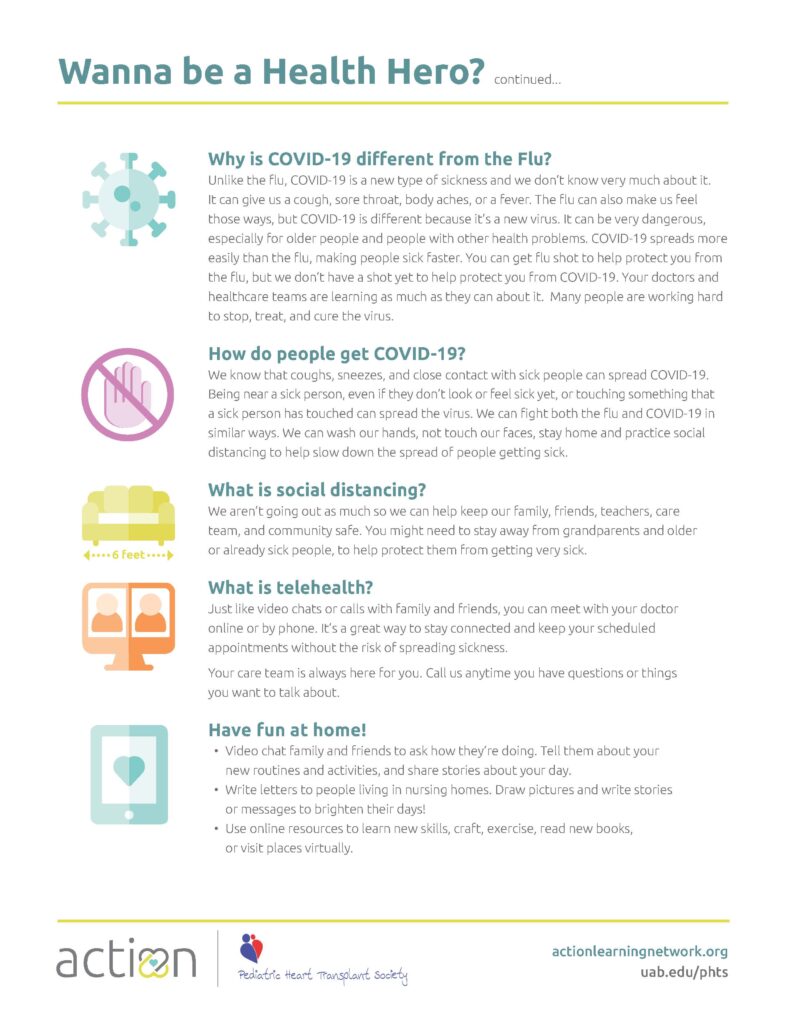
PROJECT GOALS
- Communicating general COVID-19 safety precautions to families and children
- Communicating COVID-19 safety information to children with solid organ transplants or heart failure and their caregivers
- Communicating COVID-19 safety information to healthcare leaders
OUR SOLUTION
- Our medical writers gathered three organizations’ responses into an FAQ and edited for a consistent voice and style.
- We added to the research they cited and carefully summarized the clinical outcomes to date.
- When the first study on pediatric cases of COVID-19 was published in March 2020, the Untold team summarized its key findings.
- Based on CDC guidelines for effective patient education materials, our team “chunked” the most important information into clear, kid-friendly graphics.
- Additionally, we shared smaller chunks of content on social media over a two-week period.
THE IMPACT
- These FAQ, infographics, and social media posts allowed ACTION to share critical health and safety information to help communities understand COVID-19.
- To learn more about our COVID-19 patient education content campaign, check out our white paper and listen to our CEO talk about it on the 10 Minute Tech Comm Podcast!
Communicating COVID-19 to Families and Children
In the first quarter of 2020, it felt as though the world hit “pause.” Communities struggled to slow the spread of the novel coronavirus. Our team at Untold Content, headquartered in the Midwest startup hub of Cincinnati, went completely virtual. Then we braced ourselves for the immense communication tasks ahead. We hoped for the opportunity to create COVID-19 content campaigns for our clients.
As medical storytellers, we are lucky to work with some of the most innovative healthcare organizations in the world. When news spread of COVID-19 and its rapid rate of infection, we knew there would be a critical need to communicate vital health and safety information to patients, leaders, and the general public.
This story walks you through our experience creating a communication campaign with the leaders and clinical experts at Cincinnati Children’s and the ACTION Learning Network, a global learning collaborative set to improve clinical outcomes for children with heart failure.
Storytelling can help us process overwhelming information and learn what steps to take next.
01 Tackling new terms
Before the COVID-19 pandemic, most Americans had never heard of terms like “social distancing” and “flattening the curve.” As schools and businesses closed, healthcare leaders needed to make sure everyone understood why it mattered so much to stay at a safe distance from others.
A line chart visual of “flattening the curve” swept the nation. ACTION’s graphic designer branded this iconic chart and the Untold team wrote a simple explanation of how hospital capacity is impacted by infectious disease. We placed this into an infographic 2-pager about the most important things parents need to know about COVID-19.
02 Making it relatable
How do you help children understand why they can’t go to school or play with their friends? To engage kids in social distancing, we knew they first needed to visualize what 6 feet feels like.
Couch. Bed. Tub. A professional basketball player! Metaphors help our brains compare new information to things we already understand. To reach children, we created short social media messages to help them relate to social distancing guidelines. These visuals were also featured in printable infographics for kids in the campaign theme of being a health superhero.
03 Answers at the ready
Every parent has questions about how to keep their children safe during this pandemic. But for parents of children with solid organ transplants or heart failure, those concerns are significant. Is my child at increased of getting very sick from COVID-19? How will our healthcare services be different in light of this crisis? Are there published clinical outcomes for children like mine?
As soon as news of the pandemic began, the ACTION Learning Network and Cincinnati Children’s Hospital received a wave of questions from concerned parents. Not only were they creating and adapting to new hospital operating procedures and PPE concerns, but our healthcare leaders also needed to be there to guide patients and parents.
One of the most urgent needs, therefore, was an accurate, timely, evidence-based FAQ document. ACTION partnered with the Starzl Network for Excellence in Pediatric Transplantation and the Pediatric Heart Transplant Society to collaboratively answer parents’ questions.
Our medical writers then gathered the three organizations’ responses into an FAQ and edited for a consistent voice and style. Most importantly, we added to the research they cited and carefully summarized the clinical outcomes to date. When the first study on pediatric cases of COVID-19 was published in March 2020, the Untold team summarized its key findings.
Like many data visualization artists, we debated whether it was appropriate to visualize statistics from the study. Although it was important and validated scientific data, it was also some of the only existing data. And compared to the number of children worldwide expected to have COVID-19, the study size of 2,000 children was still quite small.
Our team decided to stick with text rather than data visualization to prevent misunderstanding or extrapolation of the data. The findings, by the way, were comforting for parents: most children were asymptomatic or had mild cases of COVID-19.
04 Being a superhero
ACTION’s leaders wanted to make sure they were reaching children as well as parents. So we discussed together the most important things children should know about COVID-19. Then the Untold team ideated virtually to develop concepts. “Wanna be a health hero” was born. Because who doesn’t want to be a superhero right now?
Based on CDC guidelines for effective patient education materials, our team “chunked” the most important information into clear, concise actions children can take to protect themselves, their families, their healthcare teams, and their communities. A block layout makes the health hero actions easier to digest. Plus it adds interactivity as kids can cut and paste each superhero action!
05 Multiplying the content
From a content strategy perspective, the block layout enabled us to efficiently create multiple social media messages from just one infographic. Each superhero action is deserving of attention. So ACTION parents and children saw a new action every day over a week and a half. Simple visual icons help a wider range of kids understand and remember what to do.
06 Data tells a story
Data storytelling can help us understand how much difference just one person can make. When BBC Health published an infographic on the rate of infection with and without social distancing, our team sprang into action to brand the data and incorporate it into our COVID-19 campaign.
Seeing infection at both the individual and community level makes the impact of our actions clear. Without distancing, over 400 people would get sick. Only 15 with social distancing.
07 Key insights
So what are the key take-aways from this campaign?
- Speed and accuracy are key in times of crisis. As our team worked around the clock to write the FAQs and develop these educational materials, every second counted. The speed and accuracy of our work had a direct impact on every parent’s peace of mind. In times of crisis, we must energize and dedicate ourselves to the mission.
- Creativity is critical even in times of crisis. When we panic, we look to experts for information. But oftentimes, their content is hard to understand and access. Creative storytelling with words and visuals can bring the insights and recommendations of experts to life.
- Evidence matters, even when it’s scarce. As technology enables us to find and share information rapidly, it’s more important than ever that experts produce significant amounts of content. Rising above fake news and helping the public understand how to tell accurate info from false representation is critical.
Special thanks to the subject matter experts at Cincinnati Children’s and the ACTION Learning Network, as well as Kacie Serrato of Swash & Dot Design.
